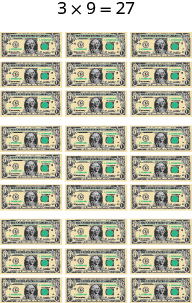Simplifying Expressions With Different Forms of the Distributive Property
Learning Outcomes
- Apply the distributive property to simplify an algebraic expression involving whole numbers, integers, fractions and decimals
- Apply the distributive property in different forms
Simplify Expressions Using the Distributive Property
Suppose three friends are going to the movies. They each need [latex]$9.25[/latex]; that is, [latex]9[/latex] dollars and [latex]1[/latex] quarter. How much money do they need all together? You can think about the dollars separately from the quarters.
 They need [latex]3[/latex] times [latex]$9[/latex], so [latex]$27[/latex], and [latex]3[/latex] times [latex]1[/latex] quarter, so [latex]75[/latex] cents. In total, they need [latex]$27.75[/latex].
If you think about doing the math in this way, you are using the Distributive Property.
They need [latex]3[/latex] times [latex]$9[/latex], so [latex]$27[/latex], and [latex]3[/latex] times [latex]1[/latex] quarter, so [latex]75[/latex] cents. In total, they need [latex]$27.75[/latex].
If you think about doing the math in this way, you are using the Distributive Property.
Distributive Property
If [latex]a,b,c[/latex] are real numbers, then [latex-display]a\left(b+c\right)=ab+ac[/latex-display]Back to our friends at the movies, we could show the math steps we take to find the total amount of money they need like this:
[latex]3(9.25)\\3(9\quad+\quad0.25)\\3(9)\quad+\quad3(0.25)\\27\quad+\quad0.75\\27.75[/latex]
In algebra, we use the Distributive Property to remove parentheses as we simplify expressions. For example, if we are asked to simplify the expression [latex]3\left(x+4\right)[/latex], the order of operations says to work in the parentheses first. But we cannot add [latex]x[/latex] and [latex]4[/latex], since they are not like terms. So we use the Distributive Property, as shown in the next example.example
Simplify: [latex]3\left(x+4\right)[/latex] Solution:| [latex]3\left(x+4\right)[/latex] | |
| Distribute. | [latex]3\cdot x+3\cdot 4[/latex] |
| Multiply. | [latex]3x+12[/latex] |

[latex]3\cdot x+3\cdot 4[/latex]
Now you try.try it
[ohm_question]146473[/ohm_question]example
Simplify: [latex]6\left(5y+1\right)[/latex]Answer: Solution:
 |
|
| Distribute. | [latex]6\cdot 5y+6\cdot 1[/latex] |
| Multiply. | [latex]30y+6[/latex] |
Answer: Solution:
 |
|
| Distribute. | [latex]2\cdot x--2\cdot 3[/latex] |
| Multiply. | [latex]2x--6[/latex] |
try it
[ohm_question]146474[/ohm_question] [ohm_question]146475[/ohm_question]different Forms of the Distributive Property
If [latex]a,b,c[/latex] are real numbers, then[latex]a\left(b+c\right)=ab+ac[/latex]
Other forms[latex]a\left(b-c\right)=ab-ac[/latex] [latex]\left(b+c\right)a=ba+ca[/latex]
Using the Distributive Property With Fractions and Decimals
Do you remember how to multiply a fraction by a whole number? We’ll need to do that in the next two examples. The distributive property comes in all shapes and sizes, and can include fractions or decimals as well.example
Simplify: [latex]\Large\frac{3}{4}\normalsize\left(n+12\right)[/latex]Answer: Solution:
 |
|
| Distribute. | [latex]\Large\frac{3}{4}\normalsize\cdot n+\Large\frac{3}{4}\normalsize\cdot 12[/latex] |
| Simplify. | [latex]\Large\frac{3}{4}\normalsize n+9[/latex] |
Answer: Solution:
 |
|
| Distribute. | [latex]8\cdot\Large\frac{3}{8}\normalsize x+8\cdot\Large\frac{1}{4}[/latex] |
| Multiply. | [latex]3x+2[/latex] |
try it
[ohm_question]146476[/ohm_question] [ohm_question]146479[/ohm_question]example
Simplify: [latex]100\left(0.3+0.25q\right)[/latex]Answer: Solution:
 |
|
| Distribute. | [latex]100(0.3)+100(0.25q)[/latex] |
| Multiply. | [latex]30+25q[/latex] |
try it
[ohm_question]146505[/ohm_question]Distributing a Variable
In the next example we’ll multiply by a variable. We’ll need to do this in a later chapter.example
Simplify: [latex]m\left(n - 4\right)[/latex]Answer: Solution:
 |
|
| Distribute. | [latex]m\cdot n--m\cdot n[/latex] |
| Multiply. | [latex]mn--4m[/latex] |
try it
[ohm_question]146506[/ohm_question]The Backwards Form of the Distributive Property
The next example will use the ‘backwards’ form of the Distributive Property, [latex]\left(b+c\right)a=ba+ca[/latex].example
Simplify: [latex]\left(x+8\right)p[/latex]Answer: Solution:
 |
|
| Distribute. |  |
try it
[ohm_question]146507[/ohm_question]Distributing a Negative Term
When you distribute a negative number, you need to be extra careful to get the signs correct.example
Simplify: [latex]-2\left(4y+1\right)[/latex]Answer: Solution:
 |
|
| Distribute. | [latex]--2\cdot 4y+(--2)\cdot 1[/latex] |
| Simplify. | [latex]--8y--2[/latex] |
Answer: Solution:
| [latex]--11(4--3a)[/latex] | |
| Distribute. | [latex]--11\cdot 4--(--11)\cdot 3a[/latex] |
| Multiply. | [latex]--44+(--33a)[/latex] |
| Simplify. | [latex]--44+33a[/latex] |
try it
[ohm_question]146512[/ohm_question] [ohm_question]146511[/ohm_question]example
Simplify: [latex]-\left(y+5\right)[/latex]Answer: Solution:
| [latex]--(y+5)[/latex] | |
| Multiplying by −1 results in the opposite. | [latex]--1(y+5)[/latex] |
| Distribute. | [latex]--1\cdot y+(--1)\cdot 5[/latex] |
| Simplify. | [latex]--y+(--5)[/latex] |
| Simplify. | [latex]--y--5[/latex] |
try it
[ohm_question]146513[/ohm_question]Licenses & Attributions
CC licensed content, Original
- Question ID 146513, 146511, 146510, 146509, 146506, 146505. Authored by: Lumen Learning. License: CC BY: Attribution.
CC licensed content, Shared previously
- Ex 1: The Distributive Property. Authored by: James Sousa (Mathispower4u.com). License: CC BY: Attribution.
- Ex 3: Combining Like Terms Requiring Distribution. Authored by: James Sousa (Mathispower4u.com). License: CC BY: Attribution.
CC licensed content, Specific attribution
- Prealgebra. Provided by: OpenStax License: CC BY: Attribution. License terms: Download for free at http://cnx.org/contents/[email protected].
